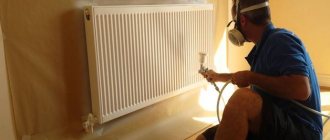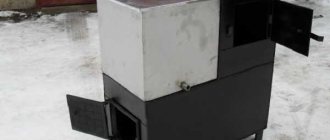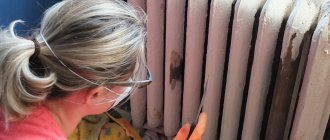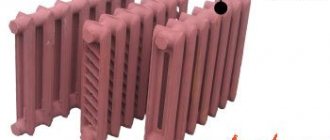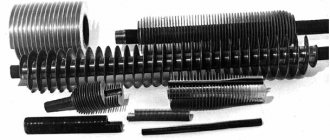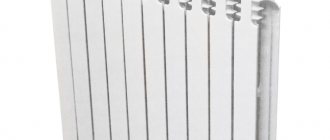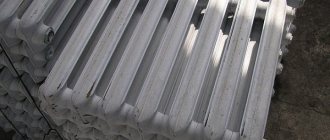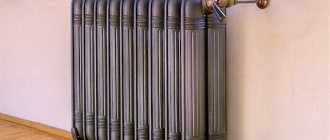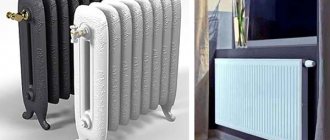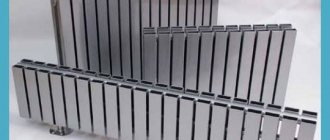Before choosing materials and the method by which you plan to paint a cast-iron heating radiator, you need to decide for yourself what is more important - to ensure the durability and reliability of the metal radiator or to achieve an aesthetic appearance, which, in general, is important, given the fact that radiators and batteries made of cast iron, even new ones from the store counter, are far from the most beautiful.
Painting the internal surfaces of the radiator is difficult and time-consuming
Is it possible to paint cast iron radiators?
It is believed that each additional layer of paint on the surface of a heating radiator reduces its efficiency by an average of 10-15%. After four layers of paint, cast iron battery registers heat up twice as bad as new ones. Therefore, the desire to paint the cast-iron radiators in the apartment for the fifth or tenth time before the start of the heating season should be restrained by reason. Why do useless work, maybe replace the radiator yourself or entrust the repair to a specialist?
Trying to paint the cast iron body of a heating battery with your own hands only makes sense in two cases:
- After installing a new radiator. This must be painted, since most likely the store will sell the battery with a primed surface;
- After a major overhaul of the battery, including eliminating leaks, replacing registers, removing fistulas or depressurizing a connection.
In any case, there is a chance not only to protect the body from rust, but also to beautifully paint the heating radiator, especially cast iron, which requires care and attention. You will need to select the appropriate paint, choose the method of applying paint that is most suitable for home conditions.
It is the last point that always remains a stumbling block. If the registers are in the basement or garage, disassembled, then it is better to paint the cast-iron radiators with powder paint. It looks better and the quality of the coating is much higher. True, in order to paint, you will have to disassemble the radiator, load it and take it to the nearest paint shop at a car service center.
Powder paint gives the highest surface quality; it lasts for 20 years
Professional painters will definitely tell you the best paint for painting cast iron batteries. Perhaps it will be a polyester resin primer or a regular material for painting discs and brake blocks. It is clear that having it painted by a professional will cost a pretty penny, but if done correctly, you can forget for 20-30 years that the cast iron body ever needs to be painted.
The fastest way to paint a radiator
But most often it is not possible to solve the problem using the described method, usually for technical reasons, so you have to look for a way to paint the cast iron batteries in the apartment. At the same time, try not to be poisoned by a toxic solvent and at the same time provide the radiators with a more or less presentable appearance.
When is battery painting necessary?
In some situations, painting radiators is not only a desire to make them more attractive in appearance, but also a need that can be caused for a number of reasons. The battery must be opened in the following cases:
- When purchasing a new battery. The need for this arises when the purchased battery is not covered with any paint.
- When carrying out repair work, if the current color of the radiator does not match the updated interior of the room.
- If during operation the battery has lost its appearance, which may result in peeling paint. In most cases, this is typical for cast iron heating devices.
Note! Regardless of the coloring composition used, cast iron batteries should be properly prepared before painting, which will make application much easier, as well as achieve better drying and a better final result.
What paint to paint cast iron radiators
First of all, you need to decide what specific paint can be used to paint the cast iron body. This is quite simple to do; the range is small; three or four main types of paints and varnishes are usually used for heating radiators:
- Transparent alkyd varnish with silver or titanium white;
- Car tint in aerosol packaging;
- Acrylic and water-dispersion paints.
If possible, you can purchase so-called hammer paint. If you paint according to the rules, then after drying the layer will have a shine and a hammered surface. The strength of the hammer mixture coating is much higher than that of standard alkyd or acrylic materials, but the layer thickness is also noticeably higher. Accordingly, paint consumption on cast iron batteries, even if spray painted, will increase by 50-60%.
Silicone-aluminum paint - expensive but effective
Important! This treatment reliably protects the cast iron base of the battery from any mechanical damage, scratches, and exposure to detergents. But you can only properly paint a new, clean battery, without traces of old paintwork.
The only significant drawback of this solution is the unattractive gray color of the battery.
Serebryanka and bronze
One way to properly paint cast iron radiators is to use paints and varnishes filled with metal powder, usually aluminum or bronze. The metal filler in the varnish increases thermal conductivity, while titanium, zinc, and lead oxides often impair heat transfer.
Silver turns out to be the most durable coating
Before applying paint, the surface is not primed, but cleaned to a metallic shine and, preferably, treated with a passivating compound. Before painting cast iron heating radiators with your own hands, rub the metal with a rag moistened with acetone or solvent No. 646.
Alkyd and pentaphthalic paints
One of the most difficult paint and varnish materials, it is possible to paint a cast iron body, but only for 4-5 years of service. The paint is viscous, you have to add a large amount of solvent, otherwise it will be very difficult to paint the cast iron battery inside the registers.
Gives a very thick coating, even with a single painting of the surface. Therefore, if you decide to paint the radiator with alkyd enamel, then it is better to choose specialized compounds and paint in one layer.
Acrylic and water-dispersed paints
On sale you can find special acrylic water-dispersion paints and varnishes. They provide a fairly beautiful coating; if you want to beautifully paint a cast iron radiator, it is better to choose acrylic heat-resistant enamel.
Water-dispersed ones are considered good for processing registers, but it is better not to use them for a cast-iron battery. Water-based emulsion does not protect metal well, and in addition, when intensely heated, it often turns yellow and becomes covered with gray dust.
Why you should not try to paint a cast iron battery
In addition to the options listed, there are at least a couple more types of paint that do not make sense to paint cast iron with. You should not paint with polyurethane and latex paints; they create a very thick layer, which increases thermal resistance and impairs heat transfer. And besides, the material ages very quickly and becomes cracked.
Oil paint has approximately the same properties. During the first two to three years after painting, the paint layer on a cast iron radiator will look absolutely perfect, but the radiator will heat very poorly.
Characteristics of paints for radiators
Packaging containers containing compositions intended for decorative finishing of heating devices must be marked “Paint for radiators.” Regardless of what components it consists of, it must have the following qualities:
- heat resistance;
- environmental friendliness;
- moisture resistance;
- abrasion resistance;
- good thermal conductivity.
Let's look at each point.
To ensure that the coating does not peel off, crack or change color, it must calmly withstand an increase in the temperature of the base to at least 80 degrees. More is better, as batteries can get very hot.
The result of applying paint with low heat resistance to heating pipes Source vsyakraska.ru
By environmentally friendly paint we mean the absence in its composition of volatile toxic substances that are released when heated. It doesn't have to be odorless radiator paint; it can smell while it dries. The main thing is that after drying, the process of releasing volatile substances stops.
Advice! To be sure that the composition is non-toxic, purchase paints produced in accordance with GOST or European standards.
Moisture resistance and abrasion resistance are characteristics that will allow you to wash batteries without fear of damaging the coating.
The higher the thermal conductivity coefficient of the paint, the less it will affect the efficiency of the heating device and its heat transfer. The thickness of the coating layer is also important here. It has been noticed that painting in 2-3 layers does not prevent heat from escaping, but each subsequent layer reduces heat transfer by 1%. This is one of the reasons why it is recommended to remove thick old coatings before restoring batteries.
One of the cleaning methods is to soften the old paint with a blowtorch and remove it with a spatula Source i.ytimg.com
It is also desirable that the composition have anti-corrosion properties, but this is not a mandatory option, subject to pre-treatment with special means.
When painting directly on site, odorless, quick-drying radiator paint is preferable. Its use will allow you not to move out of your home during the renovation. Compositions with a pungent odor are best used under conditions of good ventilation and the absence of people and animals nearby.
In addition to technical requirements, there are also aesthetic ones regarding the color of the coating and its texture. They are different for everyone. If you are satisfied with the white color of the heater - and this is the basic color that is mainly presented in stores - use the paint according to the instructions. But before buying, make sure that it does not contain chalk, which will soon turn yellow from high temperatures. It is better to pay more, but buy paint with titanium white.
If you want to paint the batteries to match the color of the walls or other interior elements, you can achieve the desired shade by mixing the base composition with a tinting paste. Moreover, it is better to tint it using special equipment, which is available in any large hardware store of the appropriate profile.
Professional tinting allows you to get exactly the right tone Source gidpokraske.ru
As for texture, battery paint comes in glossy, semi-matte and matte. The former retain the brightness of the color longer, but reveal all surface defects. Matte ones, on the contrary, mask them. Therefore, it is matte compositions that are usually used to decorate cast iron products that initially have a rough surface with metal deposits, gouges and other irregularities.
Advice! When trying to correct such defects by sanding, do not overdo it. The thinned material may not be able to cope with the load: fistulas form in it.
Repairing a leaking battery is very difficult Source gidroguru.com
What color to paint a cast iron battery
The most popular colors are white, cream, and blue; sometimes owners deliberately paint radiators white in order to improve the design of the window opening under which the battery is located. Dust is clearly visible on a white background, so you have to clean it quite often.
The optimal solution is blue, gray and beige colors. It is possible to paint the battery in darker, black and brown colors, especially since the corresponding paints are commercially available, but one can hardly expect any positive effect from such a color scheme.
Paint during the heating season or wait
The solution to this issue depends on the wishes of the apartment owners. If the renovation of the apartment has been completed, when it’s time to turn on the heating, and the radiators are left in an unsightly state, then the best option would be not to wait for spring, but to start painting right away.
An obstacle to this may be the presence of small children and elderly people in the apartment. Active ventilation of rooms where heating radiators have been painted can negatively affect their health. Then it’s really better to wait until warmer days.
Preparing cast iron batteries for painting
Most mistakes made when trying to paint a cast iron radiator relate to improper surface preparation. Painting cast iron and steel surfaces are two big differences, since the paint applies evenly to the steel and provides good adhesion.
For cast iron everything is much more complicated. It will be necessary not only to remove the old paint and primer, but also to thoroughly clean the metal, as they say, until it shines, and degrease the surface with the available hot water with soda and solvent.
The metal will need to be cleaned until it shines.
You can remove old paint using a brush attachment on a drill with bronze bristles, or try using an industrial hair dryer and the same metal brush. It is impossible to use chemical paint removers or firing with a gas torch, since with severe overheating or the use of acidic solutions, the seal between the sections will burn out first.
Do cast iron batteries need to be primed before painting?
If the battery is new and covered with factory primer, then there is no point in removing the layer. Most often, the quality of priming in a factory environment is higher than what can be achieved at home.
One of the best types of soil
The only exception is preparation for nitro paint. Usually the metal is cleaned and rubbed until shiny, after which a primer is applied based on zinc powder and nitro varnish, diluted two to three times stronger than required according to the instructions. This preparation ensures good adhesion of the nitro paint to the cast iron surface of the battery.
In other cases, it is recommended to cover a clean new or well-cleaned old battery with a thin layer of primer.
In order to obtain good adhesion, the primer is diluted one to one with P647 and rubbed into the surface with a dampened cloth. The layer of soil will turn out to be very thin, almost colorless, but this does not affect its characteristics. The paint will stick as well as on a thick layer, and the thermal resistance will decrease by 30-40%
Requirements for paint composition
The color mixture used must meet a number of the following criteria:
- Protection against the negative effects of corrosion. The composition must contain anti-corrosion elements that, in direct contact with the body, will eliminate the possibility of destruction of the coating.
- Heat resistance. The mixture with which the battery will be opened must withstand temperatures well in the range of 80-90°C and not lose its technical characteristics over the period of time specified by the manufacturer.
- Abrasion resistance. In direct contact with various objects, as well as when using heaters, dehumidifiers and other devices, the coating should not become thinner.
- Environmental friendliness. It is important that the composition does not contain elements that can harm health.
- Adhesion. It is necessary that the mixture has a high level of adhesion to the surface being treated. In addition, it should not peel off during the heating and cooling of the battery.
- Color stability. A prerequisite, since opening the heating device is also carried out with the goal of making it more attractive.
High-quality paint for radiators must meet all of the above criteria, and not just some of them.
How to properly paint old cast iron radiators
You can paint a cast iron battery quickly or efficiently. If you need to get the job done as quickly as possible, it is better to use a spray bottle or aerosol can to paint the rims. One cast iron battery will require at least two standard cylinders, which is approximately 250 g of paint.
The advantage of this method is a very thin paint layer and a high-quality glossy sheen. In addition, it is possible to paint even the most difficult to reach places, and do the job in a maximum of 10 minutes.
It is much easier to paint a cast iron battery using a spray gun, but at home or in an apartment, using a spray gun or air spray creates a lot of problems, so it is better to immediately abandon such technologies.
If you have a choice, it is best to paint the battery with a brush with very stiff bristles, no rollers or any other similar tools. The inconvenience of using such a brush is that the bristles splatter the paint a lot, so you have to take it in small portions and carefully rub it on the cast-iron surface. Working with such a tool is not very comfortable, but in any case, a hard brush allows you to qualitatively paint the oldest cast-iron battery that exists in the house.
In addition, a small brush with short, stiff bristles is very convenient for painting the inside surface of the registers. If you try to do this with a regular paint brush, most of the paint will simply flow onto the floor.
Important! The rigid base of the brush ensures good squeezing of air from under the paint layer, so after drying the paint layer will be thin, without cavities or peeling.
Painting
So, we chose heat-resistant paint, did all the preliminary work and finally got to the main thing - painting. We are guided by the rules:
- two thin layers are better than one thick one,
- The second layer is applied after the first has completely dried. And the first - after the primer has dried, if required by technology.
We use a roller or brush. For hard-to-reach areas, a narrow brush with a curved handle is perfect. We paint each section in turn from top to bottom, first where it is difficult to reach, then the side panel from the outside. Paint (as well as primer) can be in aerosol cans, which simplifies the matter.
Unless otherwise stated in the instructions, paint is applied to a cold surface!
Therefore, it is better to carry out such work with the heating turned off. Of course, if technically possible, you can temporarily turn off the supply to a separate battery or heating riser, but in any case, it is more rational to do repairs in the warm season.
How to paint an antique cast iron battery
In order to give the radiator the look of an antique heater, you need to choose the right paint color and texture. For example, you can try to design the battery in the form of a product made of non-ferrous metal, brass or copper. This will require special fillers that imitate a copper surface. You will have to paint in at least four to five layers, with intermediate polishing of each. The result is a cast iron battery very similar to the copper heat exchanger used for heating 150-200 years ago.
Antique water heating radiators often had decorative patterns; the manufacturer’s inscriptions were necessarily made on the surface, stamps and other attributes of individual production were placed. You can try to reproduce all this using stickers cut out of foil.
The decor will have to be glued to a protected cast-iron surface using heat-resistant adhesive compositions, for example, epoxy resin. After painting, the cast iron radiators will look very similar to an antique radiator.
Recommendations for coloring
First of all, it is worth noting that both solvent-based enamel and odorless radiator paint are not intended for painting on a hot surface. This is due not only to the danger of the release of toxic substances from the heated surface, but also to a violation of the drying regime. Any paint must be applied and dry at ambient and substrate temperatures from +5 to +30 degrees.
But first, the radiator needs to be prepared for painting. If the old coating is solid, without cracks or damage, it is enough to lightly rub it with fine-grain sandpaper to improve adhesion to the new layer. Then clean off any accumulated dust and degrease with white spirit or acetone.
Peeling paint and too thick layers must be removed. This can be done quickly using firing, a drill with a special abrasive attachment or a cord brush.
Removing old coating Source moidomiks.ru
Interesting ideas for painting cast iron batteries with your own hands
You can give a boring metal radiator a more personalized look with several colors or painting methods. For example, in a children's room, a cast iron radiator can be painted in several colors that best suit the color scheme of the room's interior.
For a good mood
For a hall or living room, it is best to paint the radiator in the style of wall decoration. This will make the heating system, radiator and pipes almost invisible against the background of the window trim.
A design can be applied to the front surface of the radiators, for example, imitating the technique of painting ceramic wall tiles.
In the simplest case, small inscriptions and photo tracings can be made on a white background. Using a stencil and blanks printed on a printer, you can easily turn a cast-iron battery into a cabinet covered with newspaper clippings.
The cast iron body, primed with white water-dispersion paint, can be painted with almost any basic paintwork materials, felt-tip pens, markers, and PVC painting materials. All that is required is talent, an artist's taste and a sense of proportion.
Dates and prices
The duration of the service is several working days and is determined by the complexity of the work and the workload of orders. As a rule, this is 1-2 weeks. As for prices, they depend on several factors:
- Radiator type (difficulty of surface painting).
- Original surface quality (new/old, clean/dirty, intact/chips, factory coated/primed/repainted, etc.).
- Connection type (the lower one creates additional complications).
- Color type - single or multi-tone.
- With or without cleaning (in the latter case it must be factory painted).
- If there is cleaning, its type is sandblasting, mechanical, chemical.
- With or without patina.
- Additional services - for example, varnishing after painting.
That's all. We have listed the most important points and advantages that you should keep in mind if you want to order painting of heating radiators.
Tips and tricks
We present you useful tips and recommendations for painting hot radiators during the heating season.
- During the heating season, when heating radiators are heated, it is preferable to paint them with acrylic enamels or special paint for radiators. In this case, there will be no need to ventilate the premises for a long time.
- In convectors it is not necessary, and it is impossible to paint aluminum petals. Only the protective casing is painted.
- When working with alkyd enamels, be sure to wear gloves, use a respirator, and wear goggles.

